Pheidole plagiaria
| Pheidole plagiaria | |
|---|---|

| |
| Scientific classification | |
| Kingdom: | Animalia |
| Phylum: | Arthropoda |
| Class: | Insecta |
| Order: | Hymenoptera |
| Family: | Formicidae |
| Subfamily: | Myrmicinae |
| Tribe: | Attini |
| Genus: | Pheidole |
| Species: | P. plagiaria |
| Binomial name | |
| Pheidole plagiaria Smith, F., 1860 | |
| Subspecies | |
| |
| Synonyms | |
| |
Indo-Malayan populations inhabit well-developed forests, and usually nest in rotting logs and wood fragments. On the other hand, Indo-Chinese populations often occur in forest edges and even in open lands adjacent to forests, and usually nest in the soil (Eguchi 2001). Heterick & Kitching (2022) collected this species in a ground malaise trap within a lowland dipterocarp forest in Brunei.
Identification
This species is characterized among Indo-Chinese species by the combination of the following features: in the major posterior margin of head in full-face view relatively widely and deeply concave; in the major the posteriormost part of the dorsum of vertexal lobe almost transversely rugose; in the major and minor the posterior slope of promosonotal dome with a prominence or mound; in the major outer surface of foretibia bearing relatively long decumbent-suberect hairs; in the minor median part of clypeus with a zigzag or ramified (but rarely straight) median carina which is usually accompanied with weak rugulae. The minor of this species is similar to that of Pheidole binghamii, but in the latter median part of clypeus has no rugula and the mound on the posterior slope of promesonotal dome has only a pair of hairs. (Eguchi 2008)
Keys including this Species
- Key to the Pheidole of North Vietnam
- Key to Pheidole majors and minors of Borneo
- Key to Pheidole majors of Borneo
- Key to Pheidole minors of Borneo
Distribution
Widely distributed in the Indo-Chinese, Indo-Malayan subregions and Austro-Malayan subregion.
Latitudinal Distribution Pattern
Latitudinal Range: 21.96194444° to -6.5975°.
| North Temperate |
North Subtropical |
Tropical | South Subtropical |
South Temperate |
- Source: AntMaps
Distribution based on Regional Taxon Lists
Indo-Australian Region: Borneo, Brunei Darussalam, Indonesia (type locality), Krakatau Islands, Malaysia, Philippines, Singapore.
Oriental Region: Laos, Myanmar, Thailand, Vietnam.
Palaearctic Region: China.
Distribution based on AntMaps
Distribution based on AntWeb specimens
Check data from AntWeb
Countries Occupied
| Number of countries occupied by this species based on AntWiki Regional Taxon Lists. In general, fewer countries occupied indicates a narrower range, while more countries indicates a more widespread species. |

|
Estimated Abundance
| Relative abundance based on number of AntMaps records per species (this species within the purple bar). Fewer records (to the left) indicates a less abundant/encountered species while more records (to the right) indicates more abundant/encountered species. |

|
Biology
Castes
Worker
Minor
   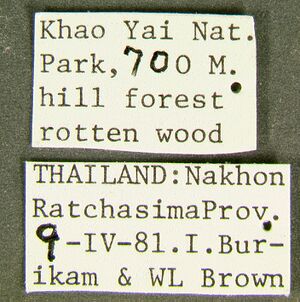        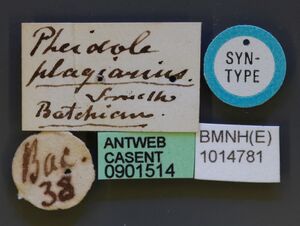 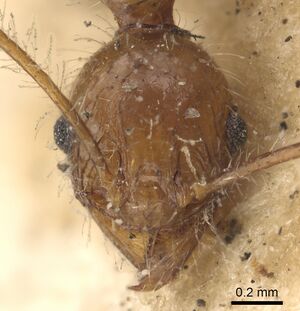    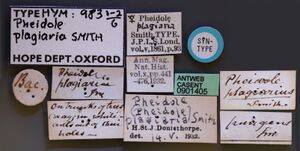
| |
| . | |
Major
  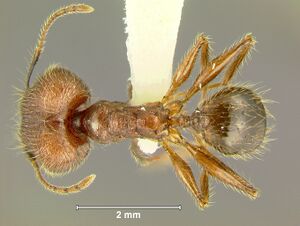   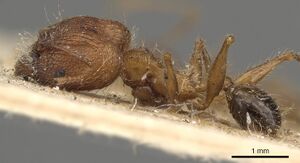           
| |
| . | |
Nomenclature
The following information is derived from Barry Bolton's Online Catalogue of the Ants of the World.
- plagiaria. Pheidole plagiaria Smith, F. 1860b: 112 (s.w.) INDONESIA (Batjan I.). Senior synonym of divergens: Mayr, 1879: 675 (in key); of yomensis: Eguchi, 2008: 73. Current subspecies: nominal plus moica, palawanica, rectilineata. See also: Eguchi, 2001b: 88.
- divergens. Pheidole divergens Mayr, 1867a: 97 (s.w.q.m.) INDONESIA. Junior synonym of plagiaria: Mayr, 1879: 675 (in key).
- yomensis. Pheidole peguensis r. yomensis Forel, 1903c: 253 (s.) MYANMAR. Junior synonym of plagiaria: Eguchi, 2008: 73.
Type Material
The following notes on F. Smith type specimens have been provided by Barry Bolton (details): Three major worker and three minor worker syntypes in Oxford University Museum of Natural History. Arranged on three cards as follows:
- Card 1. 1 major and 1 minor, labelled “Bac.” With Smith’s original label plus Donisthorpe det. labels.
- Card 2. 2 majors, labelled “Bac. 26.” With Smith det. label “plagiaria.”
- Card 3. 2 minors, labelled “Bac. 35.” With Smith det. label “plagiaria.”
Eguchi (2008):
Syntypes: 3 majors & 3 minors, “Bac” [Batjan, Indonesia], Oxford University Museum of Natural History TYPE HYM: 983 1-2/6, 3-4/6 & 5-6/6, examined.
Pheidole divergens. Syntypes: major, minor, queen & male, Indonesia, not examined.
Pheidole peguensis r. yomensis. Syntype: 1 major, “Lower Burma Pegu Yoma 1 1900 Bingham” [Myanmer], Musee d'Histoire Naturelle Genève, examined, designated as lectotype.
Current subspecies (Bolton, 1995): nominal plus moica Forel, 1911c: 222, syntype(s): major, Central part of Southern Vietnam, not examined; palawanica Stitz, 1925: 118, syntypes: 2 majors, “N. Palawan Binaluan Boettcher” [Philippines], Berlin Museum für Naturkunde der Humboldt-Universität, examined; rectilineata Viehmeyer, 1916b: 288–289, syntype(s): major, Sulawesi (in copal), not examined. Unless otherwise noted the text for the remainder of this section is reported from the publication that includes the original description.
Description
Worker
Eguchi (2008) - Major (n=5). — HL 1.65–1.89 mm, HW 1.59–1.77 mm, CI 91–98, SL 1.03–1.22 mm, SI 59–71, FL 1.42–1.70 mm, FI 85–99. Minor (n=5). — HL 0.79–0.93 mm, HW 0.67–0.75 mm, CI 81–85, SL 1.01–1.20 mm, SI 146–163, FL 1.12–1.36 mm, FI 162–181.
Major. — Head in lateral view not or only very weakly impressed on vertex; posterior margin of head in full-face view relatively widely and deeply concave; longitudinal rugulae running on the frons and then spreading posterolaterad as they run almost transversely on the posteriormost part of the dorsum of vertexal lobe; posterolateral face of head with oblique rugulae which run anteroventrad from dorsal face of vertexal lobe; frontal carina conspicuous; antennal scrobe inconspicuous or only weakly impressed; median longitudinal carina of clypeus present but weak, or rarely absent; median and submedian processes of hypostoma inconspicuous or absent; lateral processes conspicuous; outer surface of mandible covered with relatively long decumbent hairs; antenna with a 3-segmented club; maximal diameter of eye a little longer, as long as, or a little shorter than antennal segment X. Promesonotal dome in dorsal view transversely rugose with interspaces smooth to shagreened, or smooth to shagreened with sparse several transverse rugulae; the dome in lateral view with a low prominence or mound on its posterior slope; humerus of the dome not or hardly produced laterad; the dome at the humeri narrower than at the bottom; mesopleuron, metapleuron and lateral face of propodeum rugoso-reticulate, with enclosures punctured. Outer surface of foretibia bearing relatively long decumbent-suberect hairs. Petiole longer than postpetiole (excluding helcium); postpetiole not massive. First gastral tergite largely smooth and shining, but sometimes weakly punctured around its articulation with postpetiole.
Minor. — Frons and dorsal face of vertex smooth and shining, or very weakly punctured or rugoso-punctate; area between antennal insertion and eye rugose or rugoso-punctate; preoccipital carina well-developed; median part of clypeus with a zigzag or ramified (but rarely straight) median carina which is usually accompanied with weak rugulae; antenna with a 3-segmented club; scape extending far beyond posterolateral margin of head; maximal diameter of eye shorter than antennal segment X. Promesonotal dome smooth and shining, or in dorsal view concentrically rugose, with a median area smooth and shining or very weakly punctured; the posterior slope of the dome with a low mound which bears several (>2) standing hairs; humerus in dorso-oblique view not or hardly produced; mesopleuron, metapleuron and lateral face of propodeum punctured, usually overlain by weak rugoso-reticulation; propodeal spine horn-like or elongate-triangular, narrowly based, directing relatively upward. Petiole longer than postpetiole (excluding helcium); postpetiole not massive.
Karyotype
- See additional details at the Ant Chromosome Database.
 Explore: Show all Karyotype data or Search these data. See also a list of all data tables or learn how data is managed.
Explore: Show all Karyotype data or Search these data. See also a list of all data tables or learn how data is managed.
- 2n = 20 (Indonesia) (Imai et al., 1985).
References
- Eguchi, K. 2001a. A revision of the Bornean species of the ant genus Pheidole (Insecta: Hymenoptera: Formicidae: Myrmicinae). Tropics Monograph Series. 2:1-154. (page 88, see also)
- Eguchi, K. 2003. A Study on the Male Genitalia of Some Asian Species of Pheidole (Hymenoptera, Formicidae, Myrmicinae). Sociobiology 41(2): 317-355 (page 332, figs. 19A, B male genitalia described)
- Eguchi, K. 2008. A revision of Northern Vietnamese species of the ant genus Pheidole (Insecta: Hymenoptera: Formicidae: Myrmicinae). Zootaxa 1902:1-118.
- Hasin, S., Tasen, W. 2020. Ant community composition in urban areas of Bangkok, Thailand. Agriculture and Natural Resources 54: 507-514 (doi:10.34044/j.anres.2020.54.5.07).
- Hasin, S., Tasen, W., Ohashi, M., Boonriam, W., Yamada, A. 2021. Yellow crazy ants (Anoplolepis gracilipes [Smith, F., 1857]: Hymenoptera: Formicidae) threaten community of ground-dwelling arthropods in dry evergreen forests of Thailand. Agriculture and Natural Resources 55: 634-643 (doi:10.34044/j.anres.2021.55.4.14).
- Heterick, B.E., Kitching, R.L. 2022. The ants (Hymenoptera: Formicidae) of a one-hectare plot of lowland dipterocarp forest. Entomologist’s Monthly Magazine 158(4), 261–272 (doi:10.31184/m00138908.1584.4153).
- Khachonpisitsak, S., Yamane, S., Sriwichai, P., Jaitrong, W. 2020. An updated checklist of the ants of Thailand (Hymenoptera, Formicidae). ZooKeys 998, 1–182 (doi:10.3897/zookeys.998.54902).
- Latumahina, F., Borovanska, M., Musyafa, Sumardi, Susetya Putra, N., Janda, M. 2015. Ants of Ambon Island – diversity survey and checklist. ZooKeys 472, 43–57 (doi:10.3897/zookeys.472.8441).
- Mayr, G. 1879. Beiträge zur Ameisen-Fauna Asiens. Verh. K-K. Zool.-Bot. Ges. Wien 28: 645-686 (page 675, senior synonym of divergens (in key))
- Smith, F. 1860b. Catalogue of hymenopterous insects collected by Mr. A. R. Wallace in the islands of Bachian, Kaisaa, Amboyna, Gilolo, and at Dory in New Guinea. J. Proc. Linn. Soc. Lond. Zool. 5(17b)(suppl. to vol. 4 4: 93-143 (page 112, soldier, worker described)
- Wang, W.Y., Soh, E.J.Y., Yong, G.W.J., Wong, M.K.L., Benoit Guénard, Economo, E.P., Yamane, S. 2022. Remarkable diversity in a little red dot: a comprehensive checklist of known ant species in Singapore (Hymenoptera: Formicidae) with notes on ecology and taxonomy. Asian Myrmecology 15: e015006 (doi:10.20362/am.015006).
References based on Global Ant Biodiversity Informatics
- Abe T., S. Yamane, and K. Onoyama. Ants collected on the Krakatau Islands 100 years after the great eruptions. Biogeography 14: 65-75.
- Berghoff S.M., U. Maschwitz, and K.E. Linsemair. 2003. Hypogaeic and epigaeic ant diversity on Borneo: evaluation of baited sieve buckets as a study method. Tropical Zoology 16: 153-163.
- Bruhl C.A. 2001. Leaf litter ant communities in tropical lowland rain forests in Sabah, Malaysia: effects of forest disturbance and fragmentation. PHD thesis Wurzburg Universitat, 168 pp.
- Chapman, J. W., and Capco, S. R. 1951. Check list of the ants (Hymenoptera: Formicidae) of Asia. Monogr. Inst. Sci. Technol. Manila 1: 1-327
- Crawley W.C. 1924. Ants from Sumatra, with biological notes by Edward Jacobson. Annals and Magazine of Natural History (9)13: 380-409
- Davidson D. W., S. C. Cook, R. R. Snelling and T. H. Chua. 2003. Explaining the Abundance of Ants in Lowland Tropical Rainforest Canopies. Science 300: 969-972.
- Eguchi K. 2001. A revision of the Bornean species of the ant genus Pheidole (Insecta: Hymenoptera: Formicidae: Myrmicinae). Tropics Monograph Series 2: 1-154.
- Eguchi K. 2003. A study on the male genitalia of some Asian species of Pheidole (Hymenoptera, Formicidae, Myrmicinae). Sociobiology 41: 317-355.
- Eguchi K. 2008. A revision of Northern Vietnamese species of the ant genus Pheidole (Insecta: Hymenoptera: Formicidae: Myrmicinae). Zootaxa 1902: 1-118.
- Eguchi K., and S. Yamane. 2003. Species diversity of ants (Hymenoptera, Formicidae) in a lowland rainforest, northwestern Borneo. New Entomol. 52(1,2): 49-59.
- Eguchi K.; Bui T. V.; Yamane S. 2011. Generic synopsis of the Formicidae of Vietnam (Insecta: Hymenoptera), part I Myrmicinae and Pseudomyrmecinae. Zootaxa 2878: 1-61.
- Eguchi, K. 2001. A revision of the Bornean species of the ant genus Pheidole (Insecta: Hymenoptera: Formicidae: Myrmicinae). Tropics Monogr. Ser. 2: 1-154.
- Emery C. 1893. Formicides de l'Archipel Malais. Revue Suisse de Zoologie 1: 187-229.
- Emery C. 1901. Formiciden von Celebes. Zoologische Jahrbücher. Abteilung für Systematik, Geographie und Biologie der Tiere 14:565-580.
- Emery C. Formiche raccolte da Elio Modigliani in Sumatra, Engano e Mentawei. Annali del Museo Civico di Storia Naturale 40: 661-722.
- Emery, C. "Formiche raccolte da Elio Modigliani in Sumatra, Engano e Mentawei." Annali del Museo Civico di Storia Naturale Giacomo Doria (Genova) (2) 20, no. 40 (1900): 661-722.
- Emery, C. "Formicides recoltes a Buitenzorg (Java), par M. Massart." Annales de la Société Entomologique de Belgique 40 (1896): 245-249.
- Emery, C. "Voyage de MM. Bedot et Pictet dans l'Archipel Malais. Formicides de l'Archipel Malais." Revue Suisse de Zoologie 1 (1893): 187-229.
- Fontanilla A. M., A. Nakamura, Z. Xu, M. Cao, R. L. Kitching, Y. Tang, and C. J. Burwell. 2019. Taxonomic and functional ant diversity along tropical, subtropical, and subalpine elevational transects in southwest China. Insects 10, 128; doi:10.3390/insects10050128
- Forel A. 1905. Ameisen aus Java. Gesammelt von Prof. Karl Kraepelin 1904. Mitt. Naturhist. Mus. Hambg. 22: 1-26.
- Forel A. 1913k. Wissenschaftliche Ergebnisse einer Forschungsreise nach Ostindien ausgeführt im Auftrage der Kgl. Preuss. Akademie der Wissenschaften zu Berlin von H. v. Buttel-Reepen. II. Ameisen aus Sumatra, Java, Malacca und Ceylon. Gesammelt von Herrn Prof. Dr. v. Buttel-Reepen in den Jahren 1911-1912. Zoologische Jahrbücher. Abteilung für Systematik, Geographie und Biologie der Tiere 36:1-148.
- Guénard B., and R. R. Dunn. 2012. A checklist of the ants of China. Zootaxa 3558: 1-77.
- Hashimoto Y., Y. Morimoto, E. S. Widodo, and M. Mohamed. 2006. Vertical distribution pattern of ants in a Bornean tropical rainforest (Hymenoptera: Formicidae). Sociobiology 47(3): 697- 710.
- Herwina H., and K. Nakamura. 2007. Ant species diversity study using pitfall traps in a small yard in Bogor Botanic garden, West Java, Indonesia. Treubia 35: 99-116.
- Imai H. T., M. Kubota, W. L. Brown, Jr., M. Ihara, M. Tohari, and R. I. Pranata. 1985. Chromosome observations on tropical ants from Indonesia. Annu. Rep. Natl. Inst. Genet. Jpn. 35: 46-48.
- Ito, F.; Yamane, S.; Eguchi, K.; Noerdjito, W. A.; Kahono, S.; Tsuji, K.; Ohkawara, K.; Yamauchi, K.; Nishida, T.; Nakamura, K. 2001. Ant species diversity in the Bogor Botanic Garden, West Java, Indonesia, with descriptions of two new species of the genus Leptanilla (Hymenoptera, Formicidae). Tropics 10:379-404.
- Jaitrong W., B. Guenard, E. P. Economo, N. Buddhakala, and S. Yamane. 2016. A checklist of known ant species of Laos (Hymenoptera: Formicidae). Asian Myrmecology 8: 1-32. DOI: 10.20362/am.008019
- Jaitrong W., and T. Ting-Nga. 2005. Ant fauna of Peninsular Botanical Garden (Khao Chong), Trang Province, Southern Thailand (Hymenoptera: Formicidae). The Thailand Natural History Museum Journal 1(2): 137-147.
- Jaitrong W.; Nabhitabhata, J. 2005. A list of known ant species of Thailand. The Thailand Natural History Museum Journal 1(1): 9-54.
- Kadoorie Farm and Botanic Garden, 2002. Report of Rapid Biodiversity Assessments at Jianling and Shangxi Nature Reserves, Southeast Hainan, China, May 1999. South China Forest Biodiversity Survey Report Series (Online Simplified Version): No. 21. KFBG, Hong Kong SAR, ii + 18 pp.
- Katayama M., K. Kishimoto-Yamada, H. O. Tanaka, T. Endo, Y. Hashimoto, Sk. Yamane, and T. Itioka. 2015. Negative correlation between ant and spider abundances in the canopy of a Bornean tropical rain forest. Biotropica (in press).
- Kishimoto-Yamata K., F. Hyodo, M. Matsuoka, Y. Hashimoto, M. Kon, T. Ochi, S. Yamane, R. Ishii, and T. Itioka. 2012. Effects of remnant primary forests on ant and dung beetle species diversity in a secondary forest in Sarawak, Malaysia. Journal of Insect Conservation DOI 10.1007/s10841-012-9544-6
- Latumahina F., M. Borovanska, N. S. Putra, and M. Janda. 2015. Ants of Ambon Island diversity survey and checklist. ZooKeys 472: 4357.
- Liu C, B. Guénard, F Hita Garcia, S. Yamane, B. Blanchard, and E. Economo. New records of ant species from Yunnan, China. Submitted to Zookeys
- Menozzi C. 1930. Formiche di Sumatra raccolte dal Prof. J. C. van der Meer Mohr. Miscellanea Zoologica Sumatrana 47: 1-5.
- Ohasi M., Y. Maekawa, Y. Hashimoto, Y. Takematsu, S. Hasin, and S. Yamane. 2017. CO2 emission from subterranean nests of ants and termites in a tropical rain forest in Sarawak, Malaysia. Applied Soil Ecology 117–118: 147–155.
- Pfeiffer M., D. Mezger, and J. Dyckmans. 2013. Trophic ecology of tropical leaf litter ants (Hymenoptera: Formicidae) - a stable isotope study in four types of Bornean rain forest. Myrmecological News 19: 31-41.
- Pfeiffer M.; Mezger, D.; Hosoishi, S.; Bakhtiar, E. Y.; Kohout, R. J. 2011. The Formicidae of Borneo (Insecta: Hymenoptera): a preliminary species list. Asian Myrmecology 4:9-58
- Pfeiffer, M., H. Cheng Tuck, and T. Chong Lay. 2008. Exploring arboreal ant community composition and co-ccurrence patterns in plantations of oil palm Elaeis guineensis in Borneo and Peninsular Malaysia. Ecography 31(1): 21-32.
- Rizali A., M. M. Bos, D. Buchori, Sk. Yamane, and C. H. Schulze. 2008. Ants in tropical urban habitats: the myrmecofauna in a densely populated area of Bogor, West Java, Indonesia. Hayati Journal of Biosciences 15(2): 77-84.
- Rizali A., M.M. Bos, D. Buchori, Sk. Yamane, C. Hans, and J. Schulze. 2008. Ants in tropical urban habitats: the myrmecofauna in a densely populated area of Bogor, West Java, Indonesia. Hayati Journal of Biosciences 77-84.
- Smith F. 1861. Catalogue of hymenopterous insects collected by Mr. A. R. Wallace in the islands of Ceram, Celebes, Ternate, and Gilolo. [part]. Journal and Proceedings of the Linnean Society of London. Zoology 6: 36-48.
- Smith F. 1862. Catalogue of hymenopterous insects collected by Mr. A. R. Wallace in the islands of Ceram, Celebes, Ternate, and Gilolo. [concl.]. Journal and Proceedings of the Linnean Society of London. Zoology 6: 49-66.
- Smith, Fr. "Catalogue of hymenopterous insects collected by Mr. A. R. Wallace in the Islands of Bachian, Kaisaa, Amboyna, Gilolo, and at Dory in New Guinea." Journal of the Proceedings of the Linnean Society of London, Zoology 5 (1860): 93-143.
- Stitz H. 1932. Formicidae der Deutschen Limnologischen Sunda-Expedition. Arch. Hydrobiol. Suppl.-Bd. 9(Tropische Binnengewässer 2 2: 733-737
- Viehmeyer H. 1912. Ameisen aus Deutsch Neuguinea gesammelt von Dr. O. Schlaginhaufen. Nebst einem Verzeichnisse der papuanischen Arten. Abhandlungen und Berichte des Königlichen Zoologischen und Anthropologische-Ethnographischen Museums zu Dresden 14: 1-26.
- Viehmeyer H. 1913. Ameisen aus dem Kopal von Celebes. Stettiner Entomologische Zeitung 74: 141-155.
- Viehmeyer H. 1916. Ameisen von Singapore. Beobachtet und gesammelt von H. Overbeck. Archiv für Naturgeschichte (A)81(8):108-168.
- Watanasit S., S. Sonthichai, and N. Noon-anant. 2003. Preliminary survey of ants at Tarutao National Park, Southern Thailand. Songklanakarin J. Sci. Technol. 25(1) : 115-122
- Wheeler, William Morton. 1924. Ants of Krakatau and Other Islands in the Sunda Strait. Treubia. 5(1-3):1-20.
- Yamane S. 2013. A Review of the ant fauna of the Krakatau Islands, Indonesia. Bull. Kitakyushu Mus. Nat. Hist. Hum. Hist. Ser: A, 11: 1-66
- Yamane S., T. Itino, and A.R. Nona. 1996. Ground ant fauna in a Bornean dipterocarp forest. Raffles Bulletin of Zoology 44(1): 253-262.
- Yamane S.; Bui T. V.; Ogata K.; Okido H.; Eguchi K. 2002. Ant fauna of Cuc Phuong National Park, North Vietnam (Hymenoptera: Formicidae). Bulletin of the Institute of Tropical Agriculture Kyushu University 25: 51-62.


